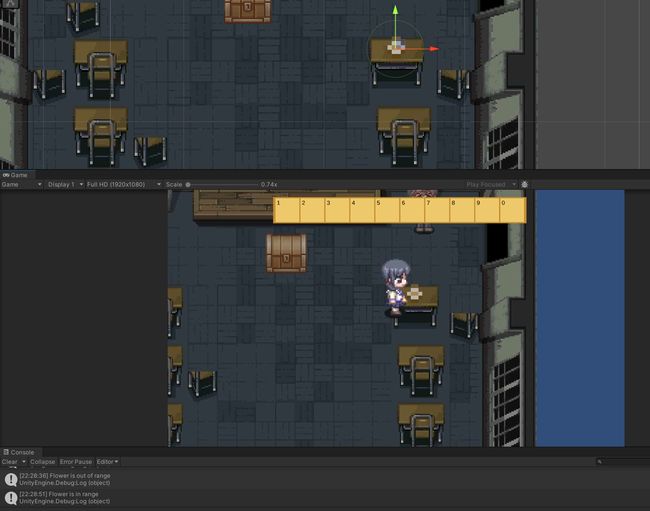【Unity】 2D 游戏 库存模块实现
库存模块主要参考了 youtube 上的视频
BMo 的 Flexible INVENTORY SYSTEM in Unity with Events and Scriptable Objects 和 Simple Inventory UI in Unity With Grid Layouts 这两个视频是一个系列
还是一个视频也是 BMo的 How To INTERACT with Game Objects using UNITY EVENTS Tutorial
这三个视频讲述了怎么用Unity Event、delegate、Collider Trigger 的功能去做一个库存系统。
但我感觉 delegate 代理类注册的写法需要在另外一个类中硬编码会比较不美观,所有换了一种两个事件调用的写法。
功能点主要有两个:一个是物品从地图进入到库存,另一个就是,反过来,物品从库存中消失。
总体来说,前者比较复杂,后者比较简单。后者的功能代码仅仅是前者的一部分。
物品从地图进入到库存中的过程有三个:人物进到物品可以交互的范围里、人物和物品交互、物品进入到人物的库存中。这三个流程可以分别设计成独立的实体。
人物进到物品可以交互的范围里
人物可以交互的范围是有限的,不然就会出现人物隔着很远的距离可以和N多个物品交互。
这块功能的实现主要是用了 Unity Collider 2D 的功能,Collider 2D不仅可以作为实体碰撞的功能,也能检测物体从范围外进入到范围内。通过在 C# 中实现 OnTriggerEnter2D 和 OnTriggerExit2D 方法,就可以达到检测人物是否进入到物品可以交互的范围里。
using System;
using System.Collections;
using System.Collections.Generic;
using UnityEngine;
using UnityEngine.Events;
public class PickUpControl : MonoBehaviour
{
public Boolean isInRange;
public KeyCode interactKey;
public UnityEvent interactEvent;
void Update()
{
if(isInRange)
{
if(Input.GetKeyDown(interactKey))
{
interactEvent.Invoke();
UnityEngine.Debug.Log($"{transform.parent.name} Interact Event invoke");
}
}
}
///
/// Sent when another object enters a trigger collider attached to this
/// object (2D physics only).
///
/// The other Collider2D involved in this collision.
void OnTriggerEnter2D(Collider2D other)
{
if(other.transform.CompareTag("Player"))
{
isInRange = true;
UnityEngine.Debug.Log($"{transform.parent.name} is in range");
}
}
///
/// Sent when another object leaves a trigger collider attached to
/// this object (2D physics only).
///
/// The other Collider2D involved in this collision.
void OnTriggerExit2D(Collider2D other)
{
if(other.transform.CompareTag("Player"))
{
isInRange = false;
UnityEngine.Debug.Log($"{transform.parent.name} is out of range");
}
}
}
(注意看左下角的Log 和 Scene 中 花所在位置的 Collider)
人物和物品交互
人物和物品的交互主要通过两个UnityEvent 交互完成,一个事件做在了 Prefab里,这个Prefab包含了一个上面说的范围检测,除此之外,还有一份受到键位交互触发事件的代码。
这段代码的作用是如果玩家已经到了交互范围内,并且按下了交互对应的案件,则会触发一个事件,这个事件是他parent transform 中对应交互的方法,例如图中的 Flower.class 的 bePickUp方法,对应花被捡起。
public Boolean isInRange;
public KeyCode interactKey;
public UnityEvent interactEvent;
void Update()
{
if(isInRange)
{
if(Input.GetKeyDown(interactKey))
{
interactEvent.Invoke();
UnityEngine.Debug.Log($"{transform.parent.name} Interact Event invoke");
}
}
}
下一个事件则是由这个Collider中绑定的事件去调用玩家库存的交互函数,并将自己的实体对象作为参数传递进去。
public class Flower : MonoBehaviour
{
public ItemData itemData;
public int number;
public UnityEvent<ItemData, int> pickUpFunction;
// Start is called before the first frame update
void Start()
{
}
// Update is called once per frame
void Update()
{
}
public void bePickedUp()
{
// 资源销毁
Destroy(gameObject);
// 玩家拾起
// ?. 是检查对应是否为空 的 C# 语法
pickUpFunction?.Invoke(itemData, number);
}
}
物品进入到人物库存中
物品进入到人物库存中,需要有一套库存相对应的代码,库存对应的概念可以是背包、仓库或者物品栏,我这里就简单以物品栏为例。
上从图中,可以简单看出物品栏有三个UI元素组成,一个物品栏,物品栏中的每一个格子与加入物品栏的物品元素。这三个都是由Unity Image 组件做的,不过物品组件多了一个 Sprite属性,可以由外界(比较说上面提到花)传入。
在我的设计中,InventoryPanel 对应了一份 InventoryManager代码,用来管理物品栏中的每一个格子。而每一个Slot对应可一份InventorySlot的代码,用来管理每一个格子对应的物品和数量。
从下而上来说,InventorySlot这份代码中,只需要做一件事,那就是构建物品图标和数量。当有新的物品加入时,就将新物品的Sprite传入到Icon属性中,数量传到 Count中。如果消除,则将这两个的enable属性改为 false,从而让物品不显示(消失)。
using System;
using System.Collections;
using System.Collections.Generic;
using TMPro;
using UnityEngine;
using UnityEngine.UI;
public class InventorySlot : MonoBehaviour
{
// Start is called before the first frame update
public Image icon;
public TextMeshProUGUI displayCount;
public InventoryItem inventoryItem;
void Start()
{
icon.enabled = false;
displayCount.enabled = false;
}
// Update is called once per frame
void Update()
{
}
public void ClearSlot()
{
icon.enabled = false;
displayCount.enabled = false;
inventoryItem = null;
}
public void DrawData(InventoryItem item)
{
if(item is null)
{
ClearSlot();
return;
}
icon.enabled = true;
displayCount.enabled = true;
inventoryItem = item;
icon.sprite = item.itemData.icon;
displayCount.text = item.number.ToString();
}
}
再说 InventoryManager,这份代码中需要写一个被交互物品可以调用的函数,这个函数的主要功能就是让物品加入物品栏时,到底是进入那一个格子。他的的入参是一个 物品对象 和 一个 int 的变量代表数量。
using System;
using System.Collections;
using System.Collections.Generic;
using UnityEngine;
public class InventoryPanelManager : MonoBehaviour
{
private List inventorySlots = new List(10);
public
// Start is called before the first frame update
void Start()
{
for(int i = 0; i < transform.childCount && i < inventorySlots.Capacity; i++)
{
inventorySlots.Add(transform.GetChild(i).GetComponent());
}
}
// Update is called once per frame
void Update()
{
}
public void add(ItemData itemData, int number)
{
InventoryItem inventoryItem = new InventoryItem(itemData, number);
Boolean sign = false;
for(int i = 0; i < inventorySlots.Capacity; i++)
{
Debug.Log($"{i} && {inventorySlots[i].inventoryItem}");
// 物品已经存在 就用Slots中已有的 和 添加的 做叠加 并写入到对应Slot中
if(inventorySlots[i].inventoryItem is not null && inventorySlots[i].inventoryItem.itemData.id.Equals(inventoryItem.itemData.id))
{
sign = true;
InventoryItem sumInventroyItem = new InventoryItem(inventoryItem.itemData, inventoryItem.number + inventorySlots[i].inventoryItem.number);
inventorySlots[i].DrawData(sumInventroyItem);
return;
}
}
// 物品不存在 找到第一个空位置 进行写数据
if(!sign)
{
for(int i = 0; i < inventorySlots.Capacity; i++)
{
if(inventorySlots[i].inventoryItem is null)
{
inventorySlots[i].DrawData(inventoryItem);
return;
}
}
}
}
}
代码在Start()函数中,会将自己的子对象中的InventorySlot类绑定到自己的列表中,供下面的方法进行调用。
而在 void add(ItemData itemData, int number)函数中,会对列表中的InventorySlot做一个遍历查询,将相同的物品进行归并,如果没有的话,就会找到一个空格子,将物品放进去。



